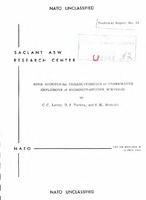| dc.contributor.author | Leroy, Claude C. | |
| dc.contributor.author | Parkes, David J. | |
| dc.contributor.author | Sirovich, Ernesto M. | |
| dc.date.accessioned | 2018-10-11T14:07:01Z | |
| dc.date.available | 2018-10-11T14:07:01Z | |
| dc.date.issued | 1963/02 | |
| dc.identifier | 2326 | |
| dc.identifier.govdoc | TR-15 | |
| dc.identifier.uri | http://hdl.handle.net/20.500.12489/320 | |
| dc.description.abstract | The acoustic characteristics of a hydrogen-oxygen explosive mixture are investigated in an attempt to find a substitute for solid explosives (e.g. TNT) which will achieve a simple underwater acoustic pulse uncomplicated by bubble oscillations. Data are shown relating the intensity and form of the acoustic signal to the proportions and amounts of gas mixture, point of ignition, hydrostatic pressure, length-to- diameter ratios of chambers, and various chamber appendages and terminations. It is shown that for certain conditions the bubble pulse can be almost suppressed or dissipated. Some experimental techniques and difficulties associated with practical application are included. | |
| dc.format | 12 p. : ill. | |
| dc.language | English | |
| dc.publisher | NATO. SACLANTCEN | |
| dc.relation.ispartofseries | AD0648042 | |
| dc.source | In: Journal of the Acoustical Society of America, vol. 35, no. 2, pp. 245-250, February 1963. | |
| dc.subject | Explosive sound sources | |
| dc.subject | Underwater explosions | |
| dc.subject | Explosives | |
| dc.title | Some acoustical characteristics of underwater explosions of hydrogen-oxygen mixtures | |
| dc.type | Scientific Technical reports (TR) | |
| dc.type | Papers and Articles | |
